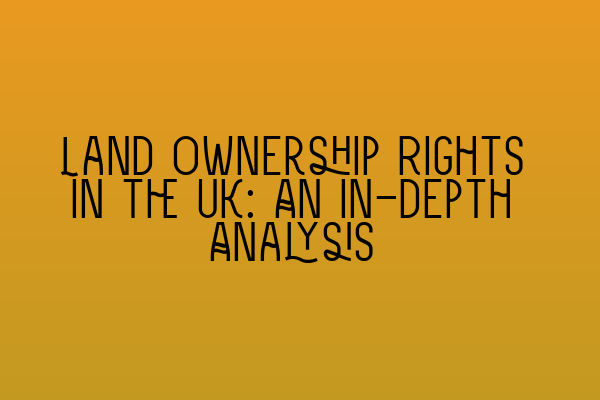Land Ownership Rights in the UK: An in-depth Analysis
Welcome to the SQE Property Law & Land Law blog series. Today, we embark on a journey to explore the intricacies of land ownership rights in the United Kingdom. Whether you are a property investor, first-time homebuyer, or legal professional, understanding the complexities of land ownership is essential in navigating the UK property market.
Throughout this article, we will delve into the various aspects of land ownership, including legal frameworks, types of land ownership, and rights associated with land. So, let’s get started!
The Legal Framework
In the UK, land ownership is mainly governed by the Land Registration Act 2002, which introduced a compulsory system of land registration. This Act established the Land Registry to manage and maintain records of land ownership.
Under the Land Registration Act 2002, land ownership is based on a system of registered or unregistered titles. Registered land is recorded in the Land Registry, providing an indisputable record of ownership. On the other hand, unregistered land relies on historical documents and deeds to establish ownership.
Types of Land Ownership
In the UK, there are two primary types of land ownership: freehold and leasehold.
1. Freehold Ownership
Freehold ownership grants the owner absolute ownership of the land and any structures on it. This means that the owner has unlimited rights to possess, use, and dispose of the land, subject only to legal and planning restrictions.
Freehold ownership is typically associated with houses, where homeowners have complete control over their properties. It provides security and autonomy, as the landowner is not dependent on any other party for land use or maintenance.
2. Leasehold Ownership
Leasehold ownership, on the other hand, provides the owner with a lease (a contractual agreement) to occupy and use the land for a specific period. The leaseholder leases the land from the freeholder, who retains the ultimate ownership.
Leasehold ownership is commonly associated with flats or apartments, where multiple dwellings occupy the same building or development. Leaseholders have specific rights and obligations outlined in their lease agreements, such as ground rent payments and maintenance responsibilities.
It is important to note that leasehold ownership is subject to certain limitations and can involve ground rent increases, lease extensions, and potential leasehold enfranchisement.
Rights Associated with Land
In addition to the type of land ownership, there are various rights associated with land in the UK.
1. Easements
Easements are rights that give individuals or entities the right to use or access another person’s land. Examples of easements include rights of way, drainage rights, and utilities access.
Understanding easements is crucial in ensuring that land use is not hindered by restrictive rights or that your land rights are protected when negotiating with neighboring landowners.
2. Restrictive Covenants
Restrictive covenants are agreements that limit the use or development of land. These restrictions may be imposed by previous landowners or local authorities to protect the character and value of an area.
Before purchasing land or property, it is essential to determine any restrictive covenants that may impact your plans or land use. Seeking legal advice can help navigate any potential conflicts.
3. Adverse Possession
Adverse possession, also known as squatter’s rights, allows individuals to claim ownership of land that they have occupied and treated as their own for an extended period. To successfully claim adverse possession, certain criteria must be met, including continuous occupation without the landowner’s permission.
Understanding adverse possession is vital in protecting your land rights and preventing any unauthorized occupation or claims on your property.
Conclusion
Land ownership rights in the UK are governed by the Land Registration Act 2002, which establishes a comprehensive system of land registration. Understanding the legal framework, types of land ownership, and associated rights is crucial for anyone involved in property transactions or seeking to protect their land rights.
We hope this in-depth analysis has provided a valuable overview of land ownership rights in the UK. If you require further information or legal assistance, don’t hesitate to reach out to the SQE Property Law & Land Law team.
For related articles and to further enhance your legal knowledge, feel free to explore our other resources:
SQE 1 Practice Mocks FLK1 FLK2
Thank you for reading, and stay tuned for more informative articles from SQE Property Law & Land Law.
